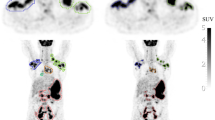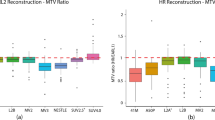Abstract
Purpose
Lymphoma detection and segmentation from PET images are critical tasks for cancer staging and treatment monitoring. However, it is still a challenge owing to the complexities of lymphoma PET data themselves, and the huge computational burdens and memory requirements for 3D volume data. In this work, an entropy-based optimization strategy for clustering is proposed to detect and segment lymphomas in 3D PET images.
Methods
To reduce computational complexity and add more feature information, billions of voxels in 3D volume data are first aggregated into supervoxels. Then, such supervoxels serve as basic data units for further clustering by using DBSCAN algorithm, in which some new feature attributes based on physical spatial information and prior knowledge are proposed. In addition, more importantly, an entropy-based objective function is constructed to search the most appropriate parameters of DBSCAN to obtain the optimal clustering results by using a genetic algorithm. This step allows to automatically adapt the parameters to each patient. Finally, a series of comparison experiments among various feature attributes are performed.
Results
48 patient data are conducted, showing the combination of three features, supervoxel intensity, geographic coordinates and organ distributions, can achieve good performance and the proposed entropy-based optimization scheme has more advantages than the existing methods.
Conclusion
The proposed entropy-based optimization strategy for clustering by integrating physical spatial attributes and prior knowledge can achieve better performance than traditional methods.



Similar content being viewed by others
References
Yu Y, Decazes P, Lapuyade-Lahorgue J, Gardinb I, Vera P, Ruan S (2018) Semi-automatic lymphoma detection and segmentation using fullyconditional random fields. Comput Med Imaging Graph 70:1–7
Black QC, Grills IS, Kestin LL, Wong CY, Wong JW, Martinez AA, Yan D (2004) Defining a radiotherapy target with positron emission tomography. Int J Radiat Oncol Biol Phys 60(4):1272–1282
Nestle U, Kremp S, Schaefer-Schuler A, Sebastian-Welsch C, Hellwig D, Rübe C, Kirsch CM (2004) Comparison of different methods for delineation of18F-FDG PET-positive tissue for target volume definition in radiotherapy ofpatients with non-small cell lung cancer. J Nucl Med 46(8):1342–1348
Tylski P, Stute S, Grotus N, Doyeux K, Hepdey S, Gardin I, Vanderlinden B, Buvat I (2010) Comparative assessment of methods for estimating tumorvolume and standardized uptake value in (18) F-FDG PET. J Nucl Med 51:268–276
Desbordes P, Petitjean C, Ruan S (2014) 3D Automated lymphoma segmentation in PET images based on cellular automata. In: 4th International conference on image processing theory, tools and applications (IPTA)
Vauclin S, Doyeux K, Hapdey S, Edet-Sanson A, Vera P, Gardin I (2009) Development of a generic thresholding algorithm for the delineation of 18 FDG-PET-positive tissue: application to the comparison of threethresholding models. Phys Med Biol 54(22):6901–6916
Grossiord É, Talbot H, Passat N, Meignan M, Najman L (2017) Automated 3D lymphoma lesion segmentation from PET/CT characteristics. In: 2017 IEEE 14th international symposium on biomedical imaging (ISBI 2017)
Bi L, Kim J, Kumar A, Wen L, Feng D, Fulham M (2017) Automatic detection and classification of regions of fdg uptake in whole-body pet-ct lymphoma studies. Comput Med Imaging Graph 60:3–10
Sibille L, Avramovic N, Spottiswoode B, Schaefers M, Zuehlsdorff S, Declerck J (2018) PET uptake classification in lymphoma and lung cancer using deep learning. J Nucl Med 59(supplement 1):325
Yu Y, Decazes P, Gardin I, Vera P, Ruan S (2017) 3D lymphoma segmentation in PET/CT images based on fully connected CRFs. In: MICCAI workshop computational methods for molecular imaging. pp 3–12
Ester M, Kriegel HP, Xu X (1996) Adensity-based algorithm for discovering clusters in large spatial databases with noise. In: Proceedings of the 2nd ACM SIGKDD. Portland, Oregon, pp 226–231
Ren X, Malik J (2003) Learning a classification model for segmentation. In: ICCV. vol 1, pp 10–17
Xu C, Corso JJ (2012) Evaluation of super-voxel methods for early video processing. In: IEEE conference on computer vision and pattern recognition (CVPR). pp 1202–1209
Lucchi A, Smith K, Achanta R, Knott G, Fua P (2012) Supervoxel-based segmentation of mitochondria in em image stacks with learned shape features. IEEE Trans Med Imaging 31(2):474–486
Kitrungrotsakul T, Chen Y-W, Han X-H, Lin L (2015) Supervoxels based graph cut for medical organ segmentation. IFAC-PapersOnLine 48(20):70–75
Ankerst M, Breunig MM, Kriegel H-P, Sander J (1999) OPTICS: ordering points to identify the clustering structure. In: ACM Sigmod record. ACM, New York, NY, USA, vol 28, pp 49–60
Ertöz L, Steinbach M, Kumar V (2003) Finding clusters of different sizes, shapes, and densities in noisy, high dimensional data. In: SDM. San Francisco, CA, USA, pp 47–58
Birant D, Kut A (2007) ST-DBSCAN: an algorithm for clustering spatial–temporal data. Data Knowl Eng 60(1):208–221
Hinneburg A, Gabriel H-H (2007) Denclue2.0: fast clustering based on kernel density estimation. In: Advances in intelligent data analysis VII. Springer, Berlin, Heidelberg, pp 70–80
Achanta R, Shaji A, Smith K, Lucchi A, Fua P, Susstrunk S (2012) Slic superpixels compared to state-of-the-art superpixel methods. IEEE Trans Pattern Anal Mach Intell 34(11):2274–2282
Shannon CE (1948) A mathematical theory of communication. Bell Syst Tech J 27:379–423
Chang H-H, Zhuang AH, Valentino DJ, Chu W-C (2009) Performance measure characterization for evaluating neuroimage segmentation algorithms. NeuroImage 47:122–135
Taha AA, Hanbury A (2015) Metrics for evaluating 3D medical image segmentation: analysis, selection, and tool. BMC Med Imaging 2015:15–29
Erdi YE, Mawlawi O, Larson SM, Imbriaco M, Yeung H, Finn R (1997) Segmentation of lung lesion volume by adaptative positron emission tomography image thresholding. Cancer Res 80(suppl.):2505–2509
Chen C-H, Muzic RF Jr, Nelson AD, Adler LP (1999) Simultaneous recovery ofsize and radioactivity concentration of small spheroids with pet data. J Nucl Med 40:118–130
Acknowledgements
The authors would like to express their appreciation to the referees for their helpful comments and suggestions. This work is co-financed by the European Union with the European regional development fund and by the Normandie Regional Council via the MoNoMaD project (Grant Number: 18P03397/18E01937).
Author information
Authors and Affiliations
Corresponding author
Ethics declarations
Conflict of interest
The authors declare that they have no conflict of interest.
Ethical approval
All procedures performed in studies involving human participants were in accordance with the ethical standards of the institutional and/or national research committee and with the 1964 Helsinki Declaration and its later amendments or comparable ethical standards.
Retrospective studies
Formal consent is not required for this type of study.
Informed consent
Informed consent was obtained from all individual participants included in the study.
Human and animal rights
This article does not contain any studies involving animals performed by any of the authors.
Additional information
Publisher's Note
Springer Nature remains neutral with regard to jurisdictional claims in published maps and institutional affiliations.
Rights and permissions
About this article
Cite this article
Hu, H., Decazes, P., Vera, P. et al. Detection and segmentation of lymphomas in 3D PET images via clustering with entropy-based optimization strategy. Int J CARS 14, 1715–1724 (2019). https://doi.org/10.1007/s11548-019-02049-2
Received:
Accepted:
Published:
Issue Date:
DOI: https://doi.org/10.1007/s11548-019-02049-2




